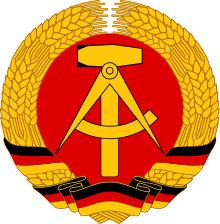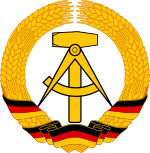State coat of arms of the German Democratic Republic
The state coat of arms of the GDR consists of a yellow / gold wreath of ears in which there is a hammer and a compass in yellow color. The wreath of ears is entwined in the lower part with a black, red and gold ribbon. The hammer symbolizes the working class , the Ährenkranz the class of farmers and the circle social layer of intelligence (academics).
history
In the GDR it was also considered to introduce an eagle which looks to the left (east). "It is advisable to act quickly on this issue, otherwise the Soviet Eastern Republic might get ahead of us." With this sentence Carl-Heinz Lüders , at that time a consultant in the Federal Ministry of the Interior, called in November 1949 for a swift decision on the national coat of arms. The forerunner of the national coat of arms consisted only of a hammer in a wreath of ears, as the GDR saw itself mainly as a workers-and-peasants state , in which workers and peasants were to rule in alliance with the intelligentsia and other classes. This design came from the draftsman Fritz Behrendt .
Until 1955 the coat of arms of the GDR was only considered unofficial and could not be called a "coat of arms". Prime Minister Otto Grotewohl declared in 1951 that the current emblem of the GDR was "semi-official" and that any indication that it was the official coat of arms of the GDR had to be avoided. This was done in order not to torpedo the all-German negotiations at the time and to create a "fait accompli" by declaring an official GDR coat of arms. Grotewohl was of the opinion that the emblem from 1950 did not capture the essence of the GDR. By a law of September 26, 1955, the coat of arms, which was valid until 1990 and is based on designs by Heinz Behling , Herbert Gute and Martin Hänisch , was introduced as the state coat of arms of the GDR - but the flag remained black, red and gold and thus identical to that of the Federal Republic of Germany . It was only with the amending law of October 1, 1959 that the state coat of arms became an integral part of the state flag of the GDR .
The national coat of arms was at the same time part of the coat of arms of the NVA and - surrounded by a 12-pointed white guard star - that of the People's Police .
After the turning point and the peaceful revolution of 1989, the state coat of arms officially remained the coat of arms of the GDR, but was no longer shown in prominent places, such as in the People's Chamber . With a resolution dated May 31, 1990, it ordered the removal of the national coat of arms from public buildings. By decision of the State Secretary in the Ministry for Disarmament and Defense of the GDR, Werner Ablaß , it was also removed from the official caps in the NVA with effect from July 20, 1990 and replaced with cockades similar to those of the Bundeswehr.
Registration with the German Patent and Trademark Office
In 2004 an attempt was made to have this symbol and other GDR symbols (such as those of the FDJ , the SED and the MfS ) protected by trademark law . The entry at the German Patent and Trademark Office was canceled in the summer of 2008 after the patent court ruled that the use of the GDR's coat of arms as a trademark was immoral .
Prohibitions and Prohibition Debates
After the GDR made the national coat of arms part of its state flag in 1959, it was banned in the Federal Republic of Germany and West Berlin . According to an agreement between the federal government and the federal states of November 4, 1959, the police were obliged to remove the GDR flag in public places - for example at sports competitions. On February 4, 1970, the Conference of Interior Ministers decided to abolish the agreement.
After reunification, there were several calls for a renewed ban on the coat of arms within the meaning of Section 86a StGb , for example from the head of the Berlin-Hohenschönhausen Memorial , Hubertus Knabe . The GDR civil rights activist Friedrich Schorlemmer , on the other hand, described such efforts as “political paranoia”. When members of a “traditional association of the National People's Army” in uniforms took part in a memorial event in Berlin in May 2013, the chairman of the CDU / CSU parliamentary group, Volker Kauder, announced that he would use the incident as an opportunity to prohibit SED symbols under criminal law -State to think about.

Old coat of arms at a Volkskammer meeting , 1950
|

Old coat of arms on a house book
|

New coat of arms at a parade of the People's Police in 1955: The hammer is shown in black on the large coat of arms on the grandstand
|
Web links
Individual evidence
- ↑ Iris Benner: Race for the eagle coat of arms. In: museumsmagazin , issue 3/2008
- ↑ State Main Archives Schwerin, Ministerpräsidium, 1345
- ^ Hormann, Plaschke: German flags. Edition Maritim, Hamburg 2006, ISBN 978-3-89225-555-0 , p. 177.
- ^ Keubke, Klaus-Ulrich & Kunz, Manfred: Military uniforms in the GDR 1949–1990, Hamburg et al. 2009, p. 218 ff.
- ↑ Federal Patent Court: Decision of the 26th Senate of July 15, 2008, Az. 26 W (pat) 4/05
- ^ Hammer, compass, wreath of ears. March 16, 2019, accessed April 7, 2019 (German).
- ↑ Interview by Deutschlandfunk with Friedrich Schorlemmer from January 4, 2014, accessed on September 30, 2016.
- ^ Second class victim. March 25, 2019, accessed on April 7, 2019 (German).


